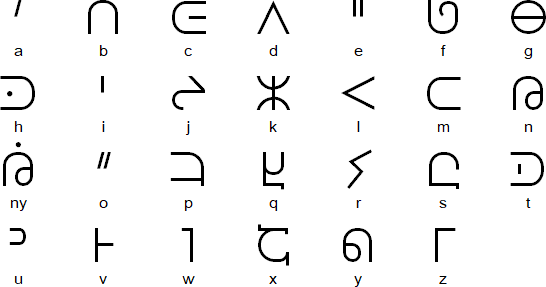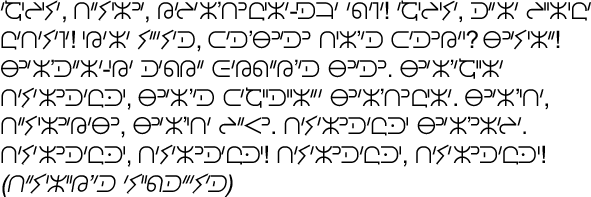The Tainonaíki Alphabet was created by Puerto Rican linguist, polyglot, and indigenous rights activist Javier A. Hernández to support and strengthen the modern Taino language, called Tainonaíki, that he reconstructed and revitalized in 2019. Javier is an enrolled member of the AraYeke Yukayek Taino Indigenous Community, which has adopted Tainonaíki as their official indigenous language.
The Tainonaíki Alphabet is an alphabet-abjad hybrid where vowels are represented as diacritical marks, yet have the status of full standalone letters along with consonants. Although phonetically, structurally, and visually intended for Tainonaíki, the Tainonaíki Alphabet is versatile and can also be used to write in Spanish and English, if needed.
The Tainonaíki Alphabet, as the co-official written form of the Tainonaíki language (along with the Latin Alphabet), was greatly modeled and influenced by the Naguaké Taino Pictographic Alphabet, various Taino petroglyphs, the Cherokee Syllabary, and Unified Canadian Aboriginal Syllabics currently used to write other indigenous languages such as Ojibwe, Cree, Inuktitut, Naskapi, Siksika, Chippewa, and Athabaskan languages such as Dakelh, Slavey, Dogrib, and Dane-zaa, among others.
The Tainonaíki Alphabet, as a new, unique, indigenous, and Pan-Taino script, is intended to be easy to learn, read, and write, characteristics that will promote literacy, linguistic development, indigenous revitalization, and its usage among modern Taino peoples, others who wish to learn Tainonaíki, and within social, family, cultural, academic, and political spheres of life.
Javier currently participates in the Taino cultural and linguistic resurgence movement that seeks to revive the lost culture, language, and traditions of his Taino ancestors. Language, of course, plays a very important part of this recovery process and many modern Tainos hope to reestablish Taino as a spoken language (via Tainonaiki). Javier feels that this process of Taino language recovery and rebirth would be better served if Tainonaiki had its own native script, thus the development and use of the modern Tainonaiki Alphabet.

Download an alphabet chart for Tainonaíki (Excel)
Download a font for the Tainonaíki Alphabet

Apúshua aránagu jemeíwa táshi óta wánawa ábo japúlima óta pansawánagu. Najak’agáma ekixíjira óta goízbaná óta toká kojutá ábo wanéya aránagu alú goíz oría ro’naboríkajat.
(Artíkulo 1 oría Banajíyaluwát Atabaríju oría Ará Pansawánagu)
A recording of this text by Javier A. Hernández
All human beings are born free and equal in dignity and rights. They are endowed with reason and conscience and should act towards one another in a spirit of brotherhood.
(Article 1 of the Universal Declaration of Human Rights)

Axíjira, boríkua, Najak’busiká-itpá ayawá! Axíjira, toká jekísa sabárawa! Ináka roarát, mat’guatú Bik’ât matunaí? Guaríko! Guak’toká-iná tayno canyon’ât guátu. Guak’axéka barakutáshi, Guak’ât maxétekoá Guak’busiká. Guak’ibá, boríkuanagu, Guak’ibá jolú. Barakutáshi Guak’úkaja. Barakutáshi, Barakutáshi! Barakutáshi, Barakutáshi!
A recording of this text by Javier A. Hernández
Tainonaíki is a reconstructed and modern variant of Taíno, an Arawakan language spoken in much of the Greater Antilles at the time of European Exploration and Conquest of the Americas. It was reconstructed by Javier A. Hernández, a Puerto Rican linguist and polyglot, who spent 15 years working on it and researching it.
Tainonaíki is a fusion of Taíno words, prefixes, and grammatical structures with words and grammatical structures of the Wayuu, Garífuna, and Arawak languages. Although the language was initially called “Taíno-Borikenaíki” due to the large amount of Taíno words and prefixes used that were sourced in Puerto Rico (Borikén), many now call the language “Tainonaíki” due to the use and infusion of other Caribbean Arawak languages and Taíno words from other islands in its lexicon and grammatical structure.
Classical Taíno, as spoken by the indigenous communities in the 1500s, is an extinct Arawakan language that was spoken throughout most of the Caribbean, except in western Cuba and parts of Hispaniola. The language was largely replaced by Spanish and other European languages during the 16th century, but was spoken in some isolated areas until the 19th century. Taíno words borrowed into English include barbeque, caiman, cannibal, canoe, cassava, guava, hammock, hurricane, iguana, maize, papaya, potato and tobacco. Unlike Classical Taíno, which is now limited to certain words and phrases, modern Tainonaíki can be learned, written, spoken, and read, thus allowing the Taíno language to be used in the 21st century by anyone wishing to use and learn it.
Tainonaíki (among other dialects) is taught in schools of the Naguaké Taíno community in Puerto Rico and is promoted by many as a tool of Taíno cultural empowerment and national restoration. Currently, Tainonaíki is the official language of the AraYeke Yukayek Taino Indigenous Community with enrolled members from Puerto Rico and other Caribbean nations.
Tainonaíki will embrace technology (apps, internet, social media) to help ensure the growth of its language community and facilitate the use and learning of Tainonaíki. Speakers and learners can even download the new iOS Tainonaíki Keyboard App to install the Tainonaíki font keyboard onto their iPhones/iPads (for emails, messages, and social media) or install the Tainonaíki font (in TTF and OTF files) directly onto their desktop PCs to use on Word, Pages, and PowerPoint documents. Tainonaíki language and writing guides, books, courses, and charts will be published as well and language learning software/courses are being developed.
Javier A Hernandez's book, Primario Básico del Taíno-Borikenaíki: Hacia la restauración del idioma ancestral de Borikén is available from: Amazon.com and Amazon.co.uk
Information about Taino | Phrases (in Taíno-Quisqueyanaíqui)
Naguaké Taíno Pictographic Alphabet | Tainonaíki Alphabet
Constructed scripts for: Ainu | Arabic | Chinese languages | Dutch | English | Hawaiian | Hungarian | Japanese | Korean | Lingala | Malay & Indonesian | Persian | Tagalog / Filipino | Russian | Sanskrit | Spanish | Taino | Turkish | Vietnamese | Welsh | Other natural languages | Colour-based scripts | Tactile scripts | Phonetic/universal scripts | Constructed scripts for constructed languages | Adaptations of existing alphabets | Fictional alphabets | Magical alphabets | A-Z index | How to submit a constructed script
[top]
You can support this site by Buying Me A Coffee, and if you like what you see on this page, you can use the buttons below to share it with people you know.

If you like this site and find it useful, you can support it by making a donation via PayPal or Patreon, or by contributing in other ways. Omniglot is how I make my living.
Note: all links on this site to Amazon.com, Amazon.co.uk
and Amazon.fr
are affiliate links. This means I earn a commission if you click on any of them and buy something. So by clicking on these links you can help to support this site.
[top]